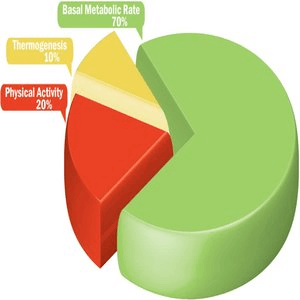What is the full form of BMRBMR: Basal Metabolic RateBMR stands for Basal Metabolic Rate. It is the measurement of energy expenditure of a person during physical, emotional and digestive rest over 24 hours. In other words, it is the amount of energy (calories) required by your body to maintain life or vital functions while you are resting at a comfortable temperature and not eating or digesting any food. BMR gives you an estimate of calories that you burn when you are at complete rest for around 24 hours. The metabolic rate is usually less than BMR during sleep. 
How to Calculate BMR in HumansIn 1919, James Arthur Harris and Francis Gano Benedict introduced an equation/formula to calculate the BMR of a person. This equation is known as the Harris-Benedict equation. Later, in 1984, this equation was revised to be more accurate. In 1990, a new equation was introduced: the Miffin-St. jeor equation. It is still in use, this equation states: P= (10.0 x m/1 kg) + (6.25 x h/1cm) - (5.00 x a/1 year) + s
For example: let us calculate the BMR of a 35-year-old male who is 180 cm tall and weighs around 90 kg. On applying Formula: P= (10.0 x 90) + (6.25 x 180 cm) - (5.00 x 35) + 5 = 900 + 1125 - 175 + 5 = 2025 - 180 = 1845 So, this person burns 1845 calories while he is resting for 24 hours. Resting Metabolic Rate (RMR) versus BMRThe terms BMR and RMR are frequently used synonymously. The two tests do, however, differ slightly in terms of what they estimate and how they are conducted. The BMR calculates the number of calories that a person would require each day to maintain their fundamental bodily processes if they were to sleep for the complete 24 hours of the day. To get an accurate assessment, a person must undergo monitoring in a clinical setting under tightly controlled conditions. These consist of:
The RMR calculates how many calories an individual burns while at rest. People don't need to speed or remain still for a long time in a controlled environment in order to get an approximation. Since testing conditions for determining the RMR are less strict than those for determining the BMR, the RMR may be a little less accurate than the BMR. Why is BMR Crucial?BMR and RMR both show how many calories a person burns while at rest. A person who is attempting to control their weight could find this information useful. Calculating a person's BMR or RMR might assist them in deciding how many calories to remove out of their diet each day if they are trying to lose weight. In some circumstances, this can include consuming just enough calories to maintain vital bodily functions. Furthermore, a person could also calculate their BMR or RMR to determine how many extra calories to ingest each day if they desire to gain weight.
Next TopicFull Form
|
 For Videos Join Our Youtube Channel: Join Now
For Videos Join Our Youtube Channel: Join Now
Feedback
- Send your Feedback to [email protected]
Help Others, Please Share










